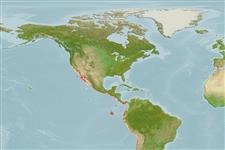>
Syngnathiformes (Pipefishes and seahorses) >
Syngnathidae (Pipefishes and seahorses) > Syngnathinae
Etymology: Hippocampus: Greek, ippos = horse + Greek,kampe = curvature (Ref. 45335).
More on author: Girard.
Environment: milieu / climate zone / depth range / distribution range
Écologie
marin récifal; non migrateur; profondeur 0 - 60 m (Ref. 30915), usually 3 - 18 m (Ref. 5227). Subtropical; 37°N - 22°S, 123°W - 70°W
Eastern Pacific: confirmed records from San Diego in California, USA to Peru including the Galapagos Islands.
Reported from the San Francisco Bay by Alexander Agassiz (Ron Fritzsche, pers.comm. 08/09).
Length at first maturity / Taille / Poids / Âge
Maturity: Lm 5.4 range ? - ? cm
Max length : 30.0 cm TL mâle / non sexé; (Ref. 2850)
Description synthétique
Clés d'identification | Morphologie | Morphométrie
Épines dorsales (Total) : 0; Rayons mous dorsaux (Total) : 18 - 21.
Nocturnal. Occur in offshore waters, mostly captured by dredging at 10 m or deeper. Occasionally caught at surface. Are often camouflaged within the branches of gorgonians and black coral trees where they are seen to curl their tail around the branches (Ref. 5227). Have been found in the stomachs of Pacific yellowfin tuna and bluefin tuna (Ref. 30915). Ovoviviparous (Ref. 205). The male carries the eggs in a brood pouch which is found under the tail (Ref. 205).
Male carries the eggs in a brood pouch (Ref. 205). Gestation period is 14-15 days depending on temperature (Ref. 30915).
Lourie, S.A., R.A. Pollom and S.J. Foster, 2016. A global revision of the seahorses Hippocampus Rafinesque 1810 (Actinopterygii: Syngnathiformes): taxonomy and biogeography with recommendations for further research. Zootaxa 4146(1):1-66. (Ref. 115213)
Statut dans la liste rouge de l'IUCN (Ref. 130435)
Menace pour l'homme
Harmless
Utilisations par l'homme
Pêcheries: commercial; Aquarium: Commercial
Outils
Articles particuliers
Télécharger en XML
Sources Internet
Estimates based on models
Preferred temperature (Ref.
123201): 19.1 - 28.5, mean 24.3 °C (based on 131 cells).
Phylogenetic diversity index (Ref.
82804): PD
50 = 0.5000 [Uniqueness, from 0.5 = low to 2.0 = high].
Bayesian length-weight: a=0.00447 (0.00177 - 0.01127), b=3.00 (2.78 - 3.22), in cm total length, based on LWR estimates for this (Sub)family-body shape (Ref.
93245).
Niveau trophique (Ref.
69278): 3.3 ±0.38 se; based on food items.
Résilience (Ref.
120179): Haut, temps minimum de doublement de population inférieur à 15 mois (tm=0.3-0.4).
Fishing Vulnerability (Ref.
59153): Low vulnerability (20 of 100).
Nutrients (Ref.
124155): Calcium = 71.1 [33.9, 167.8] mg/100g; Iron = 1.28 [0.60, 2.43] mg/100g; Protein = 18.7 [17.3, 20.0] %; Omega3 = 0.164 [0.069, 0.364] g/100g; Selenium = 32.1 [12.6, 86.2] μg/100g; VitaminA = 22.8 [5.6, 102.3] μg/100g; Zinc = 1.08 [0.61, 1.78] mg/100g (wet weight);
